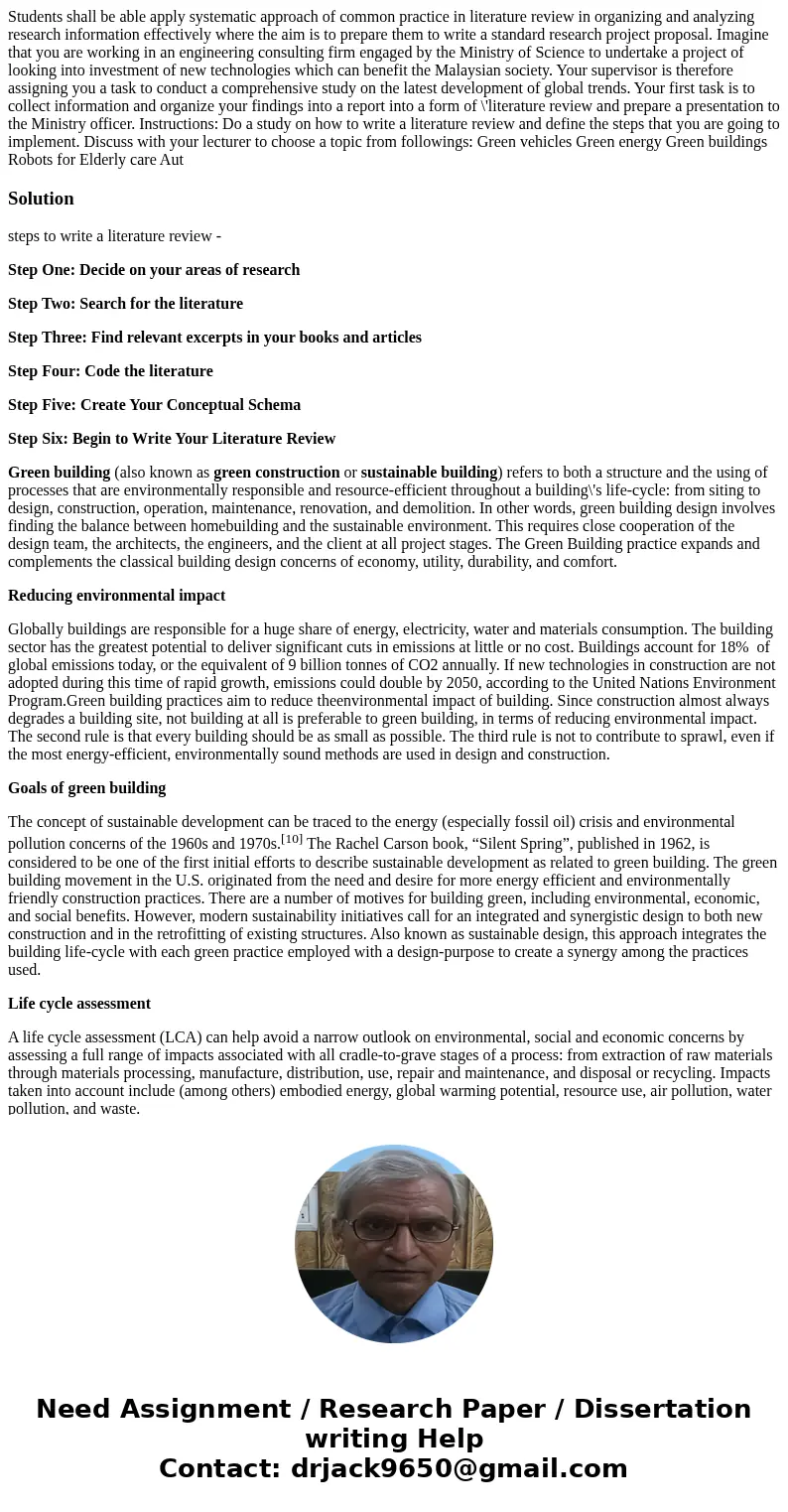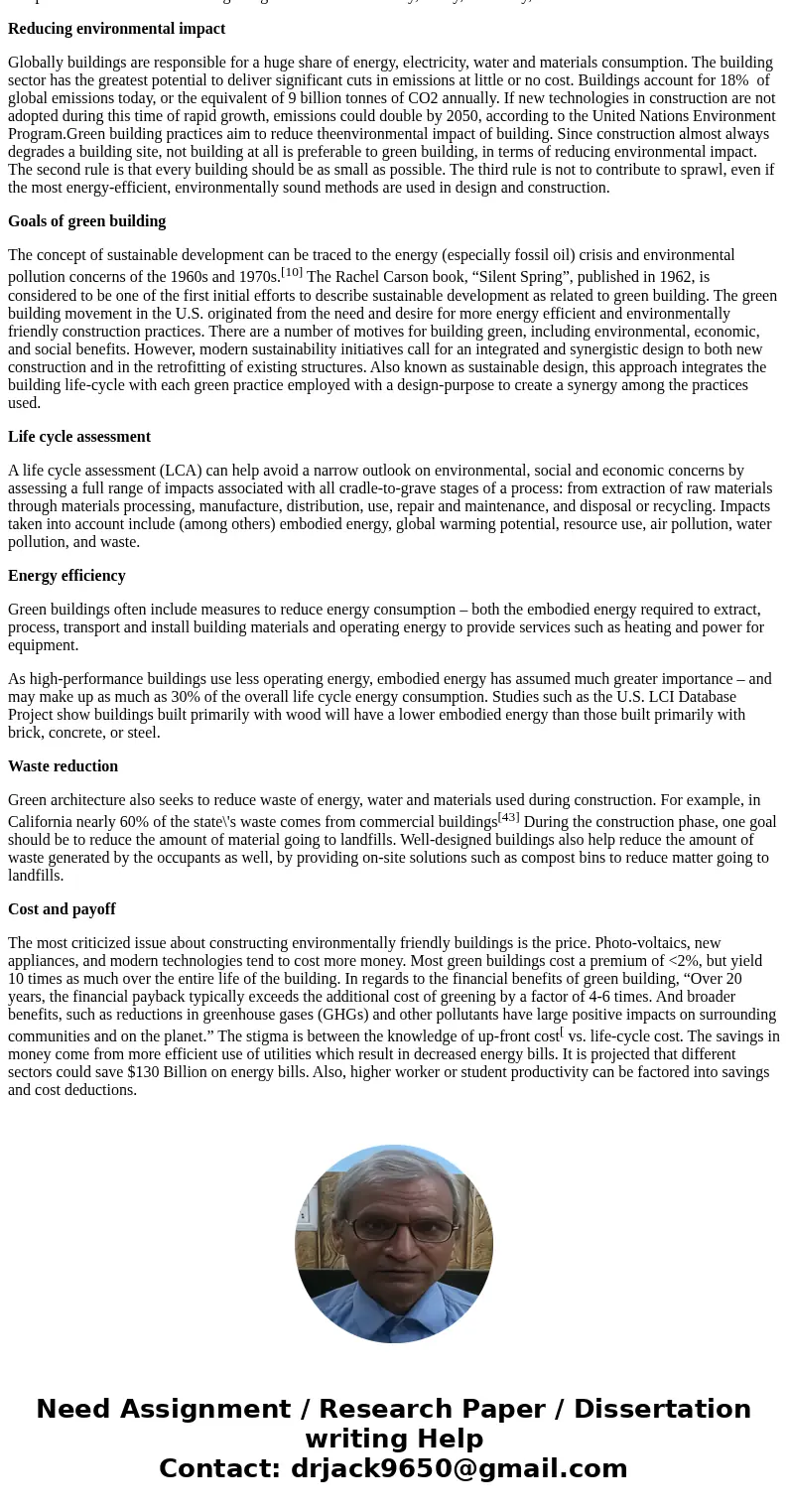Students shall be able apply systematic approach of common p
Solution
steps to write a literature review -
Step One: Decide on your areas of research
Step Two: Search for the literature
Step Three: Find relevant excerpts in your books and articles
Step Four: Code the literature
Step Five: Create Your Conceptual Schema
Step Six: Begin to Write Your Literature Review
Green building (also known as green construction or sustainable building) refers to both a structure and the using of processes that are environmentally responsible and resource-efficient throughout a building\'s life-cycle: from siting to design, construction, operation, maintenance, renovation, and demolition. In other words, green building design involves finding the balance between homebuilding and the sustainable environment. This requires close cooperation of the design team, the architects, the engineers, and the client at all project stages. The Green Building practice expands and complements the classical building design concerns of economy, utility, durability, and comfort.
Reducing environmental impact
Globally buildings are responsible for a huge share of energy, electricity, water and materials consumption. The building sector has the greatest potential to deliver significant cuts in emissions at little or no cost. Buildings account for 18% of global emissions today, or the equivalent of 9 billion tonnes of CO2 annually. If new technologies in construction are not adopted during this time of rapid growth, emissions could double by 2050, according to the United Nations Environment Program.Green building practices aim to reduce theenvironmental impact of building. Since construction almost always degrades a building site, not building at all is preferable to green building, in terms of reducing environmental impact. The second rule is that every building should be as small as possible. The third rule is not to contribute to sprawl, even if the most energy-efficient, environmentally sound methods are used in design and construction.
Goals of green building
The concept of sustainable development can be traced to the energy (especially fossil oil) crisis and environmental pollution concerns of the 1960s and 1970s.[10] The Rachel Carson book, “Silent Spring”, published in 1962, is considered to be one of the first initial efforts to describe sustainable development as related to green building. The green building movement in the U.S. originated from the need and desire for more energy efficient and environmentally friendly construction practices. There are a number of motives for building green, including environmental, economic, and social benefits. However, modern sustainability initiatives call for an integrated and synergistic design to both new construction and in the retrofitting of existing structures. Also known as sustainable design, this approach integrates the building life-cycle with each green practice employed with a design-purpose to create a synergy among the practices used.
Life cycle assessment
A life cycle assessment (LCA) can help avoid a narrow outlook on environmental, social and economic concerns by assessing a full range of impacts associated with all cradle-to-grave stages of a process: from extraction of raw materials through materials processing, manufacture, distribution, use, repair and maintenance, and disposal or recycling. Impacts taken into account include (among others) embodied energy, global warming potential, resource use, air pollution, water pollution, and waste.
Energy efficiency
Green buildings often include measures to reduce energy consumption – both the embodied energy required to extract, process, transport and install building materials and operating energy to provide services such as heating and power for equipment.
As high-performance buildings use less operating energy, embodied energy has assumed much greater importance – and may make up as much as 30% of the overall life cycle energy consumption. Studies such as the U.S. LCI Database Project show buildings built primarily with wood will have a lower embodied energy than those built primarily with brick, concrete, or steel.
Waste reduction
Green architecture also seeks to reduce waste of energy, water and materials used during construction. For example, in California nearly 60% of the state\'s waste comes from commercial buildings[43] During the construction phase, one goal should be to reduce the amount of material going to landfills. Well-designed buildings also help reduce the amount of waste generated by the occupants as well, by providing on-site solutions such as compost bins to reduce matter going to landfills.
Cost and payoff
The most criticized issue about constructing environmentally friendly buildings is the price. Photo-voltaics, new appliances, and modern technologies tend to cost more money. Most green buildings cost a premium of <2%, but yield 10 times as much over the entire life of the building. In regards to the financial benefits of green building, “Over 20 years, the financial payback typically exceeds the additional cost of greening by a factor of 4-6 times. And broader benefits, such as reductions in greenhouse gases (GHGs) and other pollutants have large positive impacts on surrounding communities and on the planet.” The stigma is between the knowledge of up-front cost[ vs. life-cycle cost. The savings in money come from more efficient use of utilities which result in decreased energy bills. It is projected that different sectors could save $130 Billion on energy bills. Also, higher worker or student productivity can be factored into savings and cost deductions.


 Homework Sourse
Homework Sourse